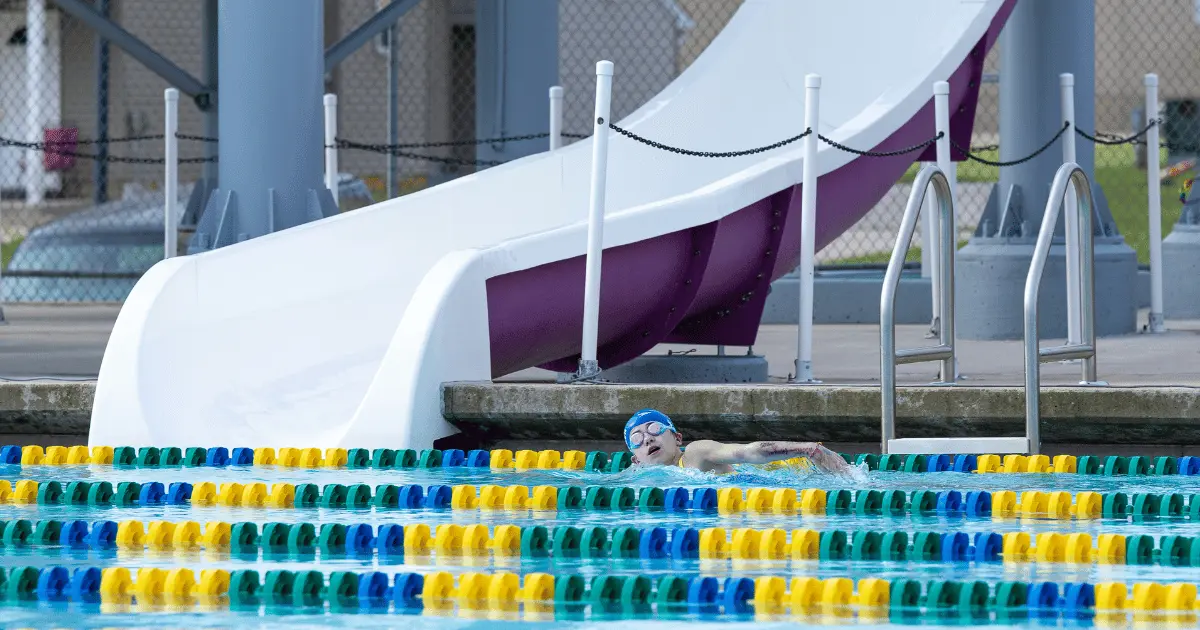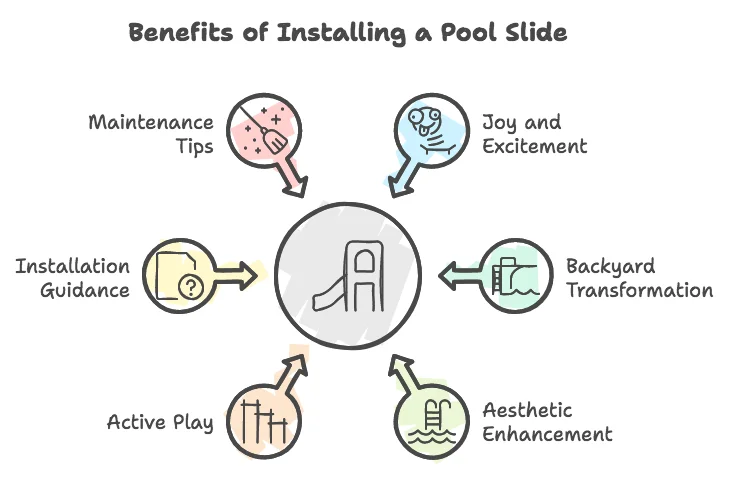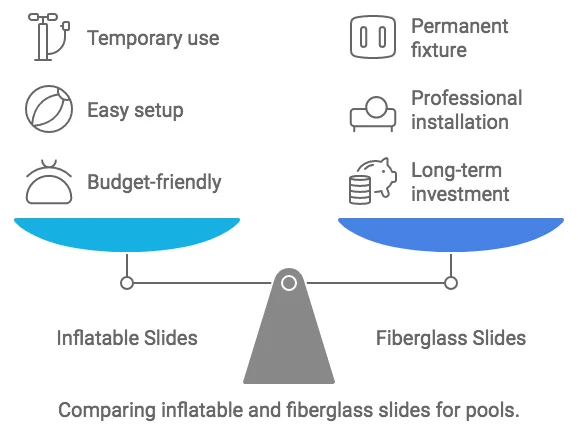CALL US NOW!
+91-213-666-0027
CALL US NOW!
+91-213-666-0027
Installing A Pool Slide Essential Guide 2024
- Home
- Installing A Pool Slide Essential Guide 2024

Introduction
Imagine the joy and excitement on your children’s faces as they zip down a pool slide, splashing into the cool water below. For homeowners with pools, Installing A Pool Slide can transform your backyard into a personal water park, providing endless fun and entertainment. Beyond the thrill, a pool slide can also enhance the aesthetic appeal of your pool area and ensure hours of active play for everyone. In this blog post, we’ll explore the benefits and types of pool slides, guide you through the installation process, and offer maintenance tips to keep your slide in top condition.
Table of Contents
Benefits of a Pool Slide
A pool slide offers numerous benefits that go beyond just fun and games. Here are some reasons why installing a pool slide is a great investment for homeowners.
Enhancing Pool Experience
A pool slide instantly elevates the excitement level of any pool party or family gathering. It provides an exhilarating activity that both kids and adults can enjoy. The addition of a slide can turn an ordinary pool day into a memorable adventure.
Promoting Physical Activity
In today’s digital age, getting children to engage in physical activities can be challenging. A pool slide encourages kids to be active, promoting physical exercise as they climb up the slide and splash into the water (saltwater) repeatedly. It’s a fantastic way to keep them moving and healthy.
Increasing Property Value
A well-designed pool slide can add significant value to your property. Potential homebuyers often see it as a desirable feature that sets your home apart from others on the market. A pool slide not only provides enjoyment but also serves as a selling point should you decide to move.
Types of Pool Slides
Choosing the right pool slide depends on various factors, including your budget, available space, and aesthetic preferences. Here are the main types of pool slides to consider:
Inflatable Pool Slides
Inflatable slides are a popular choice for homeowners looking for a temporary and budget-friendly option. These slides are easy to set up and take down, making them perfect for occasional use. They come in various sizes and designs, and their portability allows you to store them away when not in use.
Fiberglass Pool Slides
Fiberglass slides are a durable and permanent option for those looking to make a long-term investment and benefits. These slides are available in a range of shapes and sizes, offering sleek designs that can complement the look of your pool. Installation requires more effort and often professional help, but the result is a sturdy and reliable slide that can withstand years of use.
Custom-Built Pool Slides
For a truly unique and tailored experience, custom-built slides are the way to go. These slides are designed to fit your specific pool area and can include additional features like water jets, deckings or themed designs. While this option is the most expensive, it offers unparalleled customization and can significantly enhance your pool’s visual appeal.
Planning for Installation
Before installing a pool slide, proper planning is crucial to ensure a successful and safe setup. Here’s a step-by-step guide to help you get started:
Assessing Space
Measure the available space around your pool to determine where the slide will be placed. Consider the height and length of the slide, ensuring there is enough room for safe entry and exit points. Also, check for any obstacles or structures that might interfere with the installation.
Safety Considerations
Safety should be your top priority when planning a pool slide installation. Ensure the slide meets safety standards and is installed at a safe angle. The landing area should be deep enough to prevent injuries, and there should be no sharp edges or protruding objects nearby.
Budgeting
Determine your budget for the pool slide installation. Consider not only the cost of the slide itself but also any additional expenses for installation, permits, and maintenance, heating system, pool cover and extra features. Research different options and get quotes from professionals if needed to help you make an informed decision.
DIY vs. Professional Installation
When it comes to installing a pool slide, you have two options: doing it yourself or hiring a professional. Here are the pros and cons of each approach:
DIY Installation
If you’re handy and enjoy tackling projects yourself, a DIY installation might be the way to go. This option can save you money on labor costs and give you a sense of accomplishment. However, it requires careful planning, a good understanding of the installation process, and adherence to safety guidelines.
Professional Installation
Hiring a professional ensures that the slide is installed correctly and safely. Professionals have the experience and tools to handle the job efficiently, reducing the risk of errors. While this option is more expensive, it provides peace of mind knowing that the installation is done to code and professionally inspected.
Installation Process
Whether you choose a DIY approach or professional installation, the following steps outline the general process for installing a pool slide:
Step 1: Site Preparation
Begin by clearing the installation area of any debris or obstructions. Ensure the ground is level and stable to provide a solid foundation for the slide. Mark the spots where the slide’s supports will be anchored.
Step 2: Anchoring the Slide
Install the anchors according to the manufacturer’s instructions. This typically involves drilling holes into the deck or ground and securing the anchors with bolts. Make sure the anchors are firmly in place to prevent wobbling or movement.
Step 3: Attaching the Slide
With the anchors in place, attach the slide to the supports. Follow the assembly instructions carefully, ensuring all parts are securely fastened. Check for stability and make any necessary adjustments to achieve a safe and sturdy setup.
Maintenance and Safety Tips
To keep your pool slide in optimal condition and ensure safety, regular maintenance is essential. Here are some tips to help you maintain your slide:

Regular Checks
Inspect the slide regularly for any signs of wear and tear, such as cracks or loose bolts. Address any issues promptly to prevent accidents and prolong the life of the slide.
Cleaning
Keep the slide clean by washing it with mild soap and water. Remove any dirt or algae buildup to maintain a smooth surface. Avoid using harsh chemicals that could damage the slide’s material.
Use Guidelines
Establish and enforce rules for using the slide to ensure everyone’s safety. Encourage users to slide one at a time, feet first, and avoid rough play. Supervise children while they use the slide to prevent accidents.
Conclusion
Installing a pool slide can bring a world of fun and excitement to your backyard while enhancing the overall appeal of your pools area. By understanding the benefits, types, and installation process, you can make an informed decision that suits your needs and budget. Whether you choose a DIY approach or hire a professional, following the proper steps and maintaining the slide will ensure years of enjoyment for your family and friends.
Frequently Asked Questions (FAQs)
1. What safety regulations should I be aware of when installing a pool slide?
Before installing a pool slide, review local building codes and CPSC guidelines. Ensure the slide has the required water depth (3-4 feet), proper clearance, and non-slip surfaces. Obtain necessary permits and consult a professional for safe installation.
2. How does pool size affect slide installation?
Pool size is crucial to slide installation. Ensure adequate water depth (3-4 feet), deceleration space, and clearance between the slide and pool edges. Consider the slide’s size in relation to your pool’s dimensions.
3. What types of pool slides are available, and how do I choose?
Pool slides come in straight, curved, spiral, and custom designs. Materials include fiberglass, acrylic, and stainless steel. Choose based on your pool size, budget, maintenance preferences, and aesthetics.
4. What are the maintenance requirements for a pool slide?
Regular cleaning and inspections are essential. Keep the surface clean, check for damage, and replace parts as needed. Follow the manufacturer’s maintenance guidelines to extend the slide’s lifespan.
5. How much does it cost to install and maintain a pool slide?
Pool slides range from $1,000 to $20,000, depending on the design and materials. Consider installation, regular maintenance, insurance impacts, and potential property value changes when budgeting.


